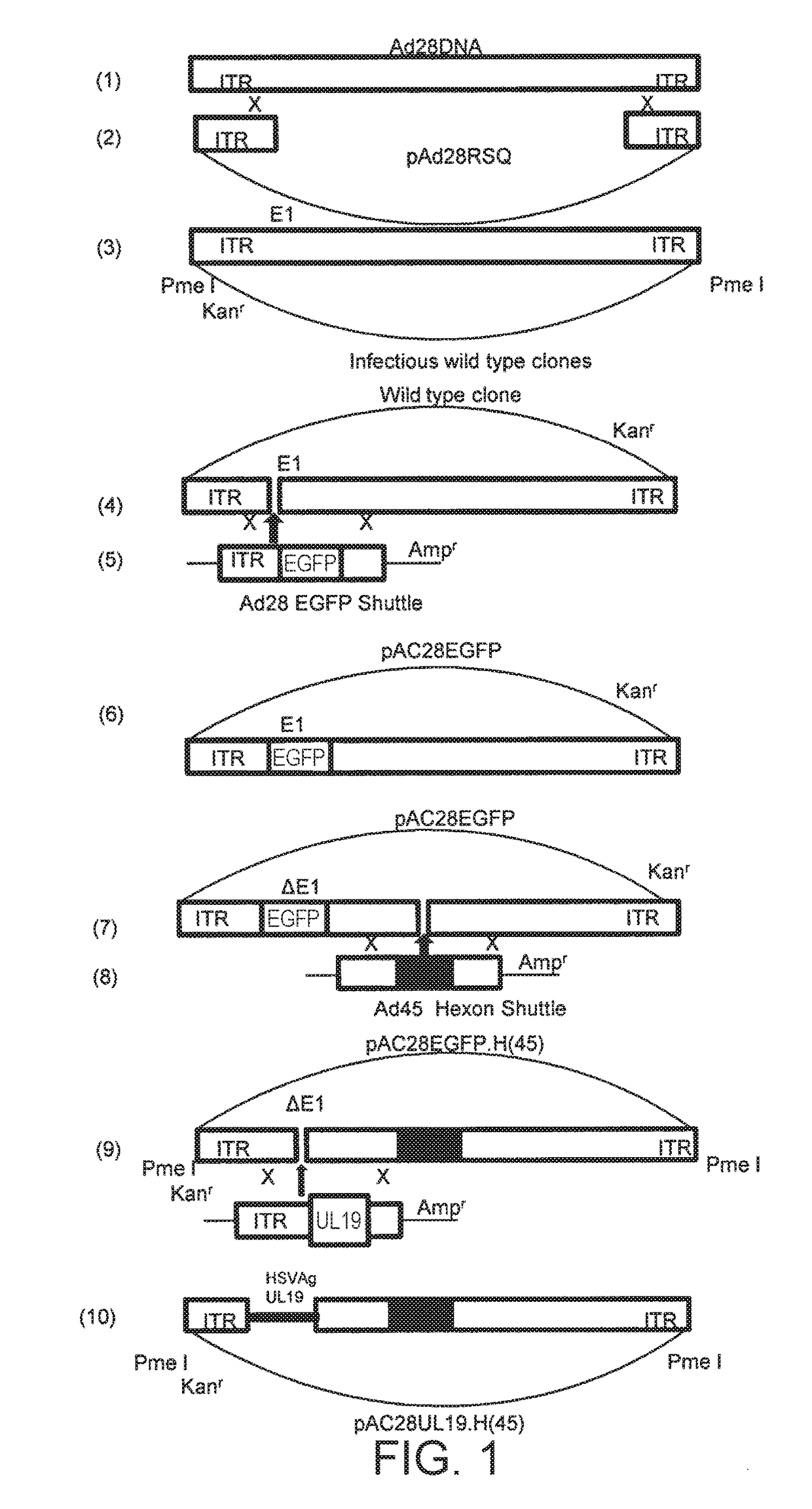Modified serotype 28 adenoviral vectors
a technology of adenovirus and vector, which is applied in the direction of dsdna viruses, viruses/bacteriophages, genetic material ingredients, etc., can solve the problems of affecting the biological relevance of proteins, affecting the widespread use of viral gene transfer vectors, and affecting the ability of certain cells to be readily amenable to gene delivery
- Summary
- Abstract
- Description
- Claims
- Application Information
AI Technical Summary
Benefits of technology
Problems solved by technology
Method used
Image
Examples
example 1
[0063]This example demonstrates the construction of a serotype 28 adenoviral vector comprising a serotype 45 adenovirus hexon protein and a serotype 45 adenovirus fiber protein, which encodes a Herpes Simplex Virus-2 (HSV) antigen.
[0064]A human serotype 28 adenoviral vector was prepared with a deletion in the E1 region, a portion of the hexon protein replaced with a portion of the hexon protein of a human serotype 45 adenovirus, and an insertion of a codon-optimized nucleic acid sequence encoding a wild-type HSV-2 UL19 protein into the E1 region (Ad28UL19 H(Ad45)). Ad28UL19 H(Ad45) is replication-deficient due to the deletion of the essential replication function provided by E1. In place of the E1 sequences, a CMVtetO UL19 expression cassette was introduced to provide the HSV-2 UL19 nucleic acid sequence. The expression cassette, located at the E1 region deletion junction, was oriented right-to-left with respect to the viral genome.
[0065]Ad28UL19 H(Ad45) has an E1 region deletion of...
example 2
[0071]This example demonstrates that the administration of the inventive serotype 28 adenoviral vector encoding one or more HSV antigens induces an immune response against HSV.
[0072]A serotype 28 adenoviral vector comprising portions of the hexon and fiber proteins from a serotype 45 adenovirus vector (Ad28 H / F) was produced using the methods described in Example 1. A first such adenoviral vector comprised a nucleic acid sequence encoding a wild-type HSV-2 UL47 protein (SEQ ID NO: 11). A second such adenoviral vector comprised a codon-optimized nucleic acid sequence encoding a wild-type HSV-2 UL19 protein (SEQ ID NO: 12).
[0073]T-cell response following a single intramuscular administration of each of the adenoviral vector-delivered antigens (1×109PU) was assessed in a mouse model and compared to natural infection (1×106PFU of HSV administered intravaginally) and control (i.e., formulation buffer (FFB)). A single administration of the adenoviral vector encoding either HSV-2 antigen i...
example 3
[0075]This example demonstrates that the administration of the inventive serotype 28 adenoviral vector encoding one or more HSV antigens induces an immune response against HSV.
[0076]Mice were divided into groups of four, and each group received a single intramuscular administration of one of the following: (a) an E1-deleted serotype 5 adenoviral vector encoding an HSV2 UL19 protein, (b) an E1-deleted serotype 28 adenoviral vector encoding an HSV2 UL19 protein, (c) the Ad28 H / F vector of the invention as described in Example 2, which encodes an HSV2 UL19 protein, and (d) formulation buffer (FFB; negative control). CD8+ T-cell responses following vaccination with the adenoviral vectors (1×109PU) were assessed. The elicited T-cell responses are plotted in the graph of FIG. 2.
[0077]As is apparent from the results depicted in FIG. 2, a single administration of the Ad28H / F vector elicited a strong CD8+ T-cell response that was comparable to the CD8+ T-cell response elicited by the Ad5 vec...
PUM
 Login to View More
Login to View More Abstract
Description
Claims
Application Information
 Login to View More
Login to View More - R&D
- Intellectual Property
- Life Sciences
- Materials
- Tech Scout
- Unparalleled Data Quality
- Higher Quality Content
- 60% Fewer Hallucinations
Browse by: Latest US Patents, China's latest patents, Technical Efficacy Thesaurus, Application Domain, Technology Topic, Popular Technical Reports.
© 2025 PatSnap. All rights reserved.Legal|Privacy policy|Modern Slavery Act Transparency Statement|Sitemap|About US| Contact US: help@patsnap.com


